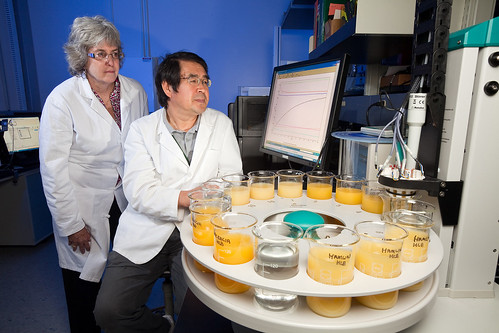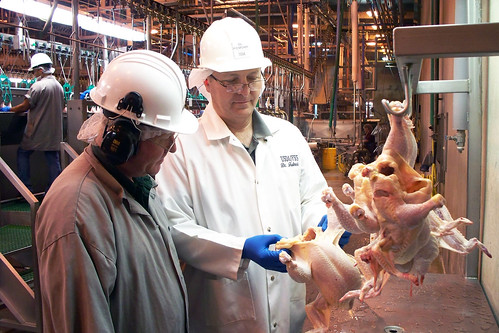
Less than 2 years ago, the USDA and the U.S. Environmental Protection Agency (EPA) launched the U.S. Food Waste Challenge, with the goal of reducing food waste in the United States. We set an ambitious goal of having at least 400 businesses, schools, and/or organizations join the challenge by letting us know what they are doing to reduce food waste in their operations. USDA also committed to finding ways in which its 33 agencies and offices could help reduce food waste through policy, partnerships, and research.
As of today, we have surpassed our membership goal by signing up 1,313 participants in the U.S. Food Waste Challenge.
The number and diversity of participants joining the challenge are indicative of a growing movement to reduce food waste that is spreading across the country.
Founding members, Rio Farms, Unilever, General Mills, and the Food Waste Reduction Alliance have been joined by members from across the food supply chain. Hannaford, a supermarket chain in the Northeast, recently joined the U.S. Food Waste Challenge and shared the many ways in which it keeps food from ending up in landfills. Using the “food recovery hierarchy,” Hannaford tries to reduce food waste at the source by having fresh products delivered on a daily basis instead of 3-4 times per week. Daily deliveries lead to more accurate ordering, less food waste, and improvements in quality. Safeway, another supermarket chain participating in the U.S. Food Waste Challenge, donates the wholesome, edible food that goes unsold in their stores to feed hungry people. In 2013, Safeway recovered and donated 72 million pounds of food to hunger relief organizations.
Other participants in our challenge like K-12 schools, universities, and sports teams are also involved in food recovery and donation activities. With the help of organizations like Campus Kitchens and Food Recovery Network, over 120 colleges and universities have started food recovery efforts in their dining facilities to donate wholesome unsold food to local food pantries. Sports teams like the Milwaukee Brewers and movie studios like NBC Universal have also signed up for the challenge because of their work with Rock and Wrap It Up!, an organization that recovers and donates unsold food at sporting events and movie shoots.
Moving down the food recovery hierarchy, some participants in our challenge keep food from landfills by converting it to livestock feed. Four Minnesota schools in the Chisago Lakes School District have their food waste picked up by Barthold Pig Farm, where it is then heated and fed to pigs. The 72 McDonalds’ in Hawaii now sell their used cooking oil to Pacific Biodiesel, where it is then recycled into fuel.
Not to be outdone by all of our U.S. Food Waste Challenge participants, the USDA also delivered on reducing food waste through our policies, partnerships, and research. USDA Economic Research Service (ERS) continues to study and provide estimates on how much food goes uneaten at the retail and consumer level. The estimated pounds, monetary value, and calories of food loss that USDA ERS reports helps policymakers, the food industry, and nonprofits better explain the food waste issue to the public, make recommendations, and set targeted goals.
Through the Agricultural Research Service (ARS), the USDA is researching and developing new products that help 1) reduce food spoilage; 2) reuse waste from food processing to produce new value-added products; and 3) recycle food waste into livestock feed or biobased products such as biodegradable plastics. ARS, for example, helped Gorge Delight, a grower-owned business, develop a 100% fruit bar that uses blemished or damaged apples and pears from their orchards that would have otherwise been discarded. Not only does ARS’s work help reduce food waste, but it also creates new economic opportunities in rural areas.
For consumers and families, USDA Food Safety and Inspection Service (FSIS) has updated the “Ask Karen” website, which is visited over 10 million times a year, to answer people’s questions on how to safely handle, prepare, and store food. FSIS, which is responsible for ensuring that the nation’s commercial supply of meat, poultry, and egg products is safe and correctly labeled, recently streamlined procedures for donating wholesome misbranded meat and poultry products. In April 2014, as a result of this directive, FSIS was involved in the donation of approximately 84,310 pounds of misbranded pork sausage. The misbranded product was donated to the Westmoreland County Food Bank and Greater Pittsburgh Community Food Bank.
Finally, here at USDA headquarters in Washington, D.C., the cafeteria, which serves up to 3,000 people a day, has found some innovative ways to reduce food waste. The dining service company, IL Creations, holds “Happy Hour” from 2:30 pm – 3:00 pm, at which food is sold at a 30% discount to reduce the amount of unsold leftovers. For people with eyes bigger than their stomachs, USDA has promoted composting and made it easy for employees by placing composting bins all over the building. In 2014, USDA headquarters composted about 2,650 pounds of food waste per week. This represents about a 10% increase from 2013, which is double our original goal of a 5% increase.
The goal we had for launching the U.S. Food Waste Challenge was to help inspire organizations and individuals across the food supply chain to start reducing, recovering, and recycling food waste in their day-to-day operations. What we didn’t expect was how much your energy, passion, and support would push us to do more. Indeed there is so much more work to be done to reduce food waste in America, and we want to continue working on this issue for years to come.

